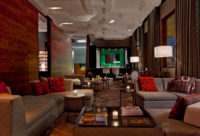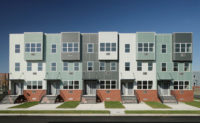Stone Creek Camp by Andersson-Wise Architects
Bigfork, Montana




















































Architects & Firms
People have an inherent craving for an unimpeded prospect, coupled with a need to find refuge, as the British geographer Jay Appleton noted in his 1975 book The Experience of Landscape. In other words, humans want to have a view and a place to hide. Appleton’s theories inspired architects Arthur Andersson and Chris Wise of Austin, Texas, in their design of a four-building compound in northwestern Montana.
Additional Content:
Jump to credits & specifications
Descending a narrow gravel path through dense forest, you encounter first the compound’s 1,859-square-foot gatehouse, then a 5,358-square-foot lodge, a 2,073-square-foot guesthouse, and, closest to the lake, a 3,231-square-foot “master” house. Here the clients have their bedroom, baths, sitting room, and two offices.
Each of the buildings possesses its own personality, yet all have intimate, cavelike spaces and expansive porches. Movable walls provide seamless connections between the inside and outside, plus dramatic views of the lake.
While the gatehouse, guesthouse, and lodge are all clad in black-stained cedar with pitched Corten steel roofs, the master house stands out as the pièce de résistance. Designed as a sculptural object in the landscape, it provides a separate place for the clients to retreat from family and guests.
On the upper side of the house, the architects built walls of reused Douglas fir, larch, and grand fir trees that were cleared on the site. Milled to standard cordwood size, the logs are dry-stacked on either side of an insulated, waterproof layer, and secured with blind fasteners.
In addition, rock walls of locally quarried granite and a planted roof make this house feel refined yet humble — civilized with a natural roughness that fits its setting.
The master house, as well as the other three buildings on the site, was strategically placed to avoid impeding the path of a series of underground streams that flow to the lake.
These streams help irrigate other, more civilized spaces carved out of the wilderness — most notably a lawn that slopes down to the water. “If I could pick one word to describe the spaces, both inside and out,” says Connie Stone, “I’d call them ‘pure.’ Everything is resolved, everything is correct.” And the spaces achieve their intended dual role.
PeopleOwner: Martin & Connie Stone
Architect: Andersson•Wise Architects Personnel in architect's firm who should receive special credit:
Interior designer: London Boone Interiors
Engineer(s): Structural Engineer: Mep Engineer: Geotechnical Engineer:
Consultant(s): Landscape:
General contractor: Bigfork Builders AND Martel Construction
Photographer(s): Art Gray, 310-663-4756
CAD system, project management, or other software used: Vectorworks |
ProductsStructural system Wood Frame Wood: Douglas Fir, Alaskan Cedar
Roofing Other: Weathered Steel
Windows Wood:
Glazing Glass: Cardinal
Doors Metal doors: Elison Bronze Wood doors: Upswinging doors, other:
Hardware Locksets: Frant Allart Cabinet hardware: Haefele
Interior finishes Paints and stains: Benjamin Moore, Sherwin Williams, and Sikkens Floor and wall tile: Daltile & Waterworks
Lighting Interior ambient lighting: Ardee Downlights: Lucifur Exterior: Teka
Plumbing Waterworks and Chicago Faucets |





























